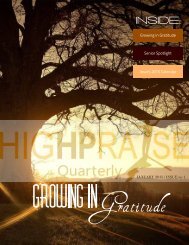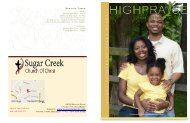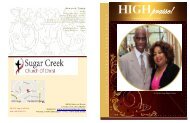Create successful ePaper yourself
Turn your PDF publications into a flip-book with our unique Google optimized e-Paper software.
George Villiers (1592-1628). By all accounts, George had great charm and stunning good<br />
looks. James was soon hopelessly in love with him. In August 1615, George Villiers<br />
confessed that he “gave in to the King’s importunity”, also hinting at activity in bed. At that<br />
time, sodomy was against the law. James himself officially condemned it as one of the sins<br />
that cannot be forgiven.<br />
James said, “Christ had his John, and I have my George.” George wrote flatteringly to<br />
James: “I naturally so love your person, and adore all your other parts, which are more than<br />
ever one man had”. He also carefully cultivated Prince Charles, securing his favour and<br />
affection, too. By 1624, they had become close companions with Charles, too, addressing<br />
Villiers in his letters as “sweetheart”.<br />
Religion and Politics<br />
The extraordinary global career of this book, of which more copies have been made than of<br />
any other book in the language, began in March 1603. After a long reign as Queen of<br />
England, Elizabeth I finally died. This was the moment her cousin and heir, the Scottish King<br />
James VI, had been waiting for. Scotland was one of the poorest kingdoms in Europe, with a<br />
weak and feeble crown. England by comparison was civilized, fertile, and rich. When James<br />
heard that he was at last going to inherit the throne of England, it was said that he was like "a<br />
poor man … now arrived at the Land of Promise."<br />
In the course of the 16th century, England had undergone something of a yo-yo Reformation,<br />
veering from one reign to the next between Protestant and anti-Protestant regimes, never<br />
quite settling into either camp. The result was that England had two competing versions of<br />
the Holy Scriptures. The Geneva Bible, published in 1560 by a small team of Scots and<br />
English Calvinists in Geneva, drew on the pioneering translation by William Tyndale, martyred<br />
for his heresy in 1536.<br />
This was a world in which there was no gap between politics and religion. A translation of the<br />
Bible that could be true to the original Scriptures, be accessible to the people, and embody<br />
the kingliness of God would be the most effective political tool anyone in 17th-century<br />
England could imagine. "We desire that the Scripture may speake like it selfe," the translators<br />
wrote in the preface to the 1611 Bible, "that it may bee understood even of the very vulgar."<br />
A New Translation<br />
A man named John Reynolds who led the Puritan party and who was president of Corpus<br />
Christi College at Oxford, suggested that there should be a new translation of the Bible<br />
because the translations used during the reigns of Henry VIII and Edward VI were corrupt, not<br />
holding to the original documents.<br />
It is worth mentioning that a translation comes directly from the Hebrew and Greek<br />
languages. It is different from a paraphrase, which is a person's interpretation taken from a<br />
translation that already exists. King James was very open to this idea. He believed that the<br />
Bible should be able to be read and understood by the common person. This is interesting<br />
because at the time, most of the common populace was illiterate. However, the text could be,<br />
and was, read aloud.

















